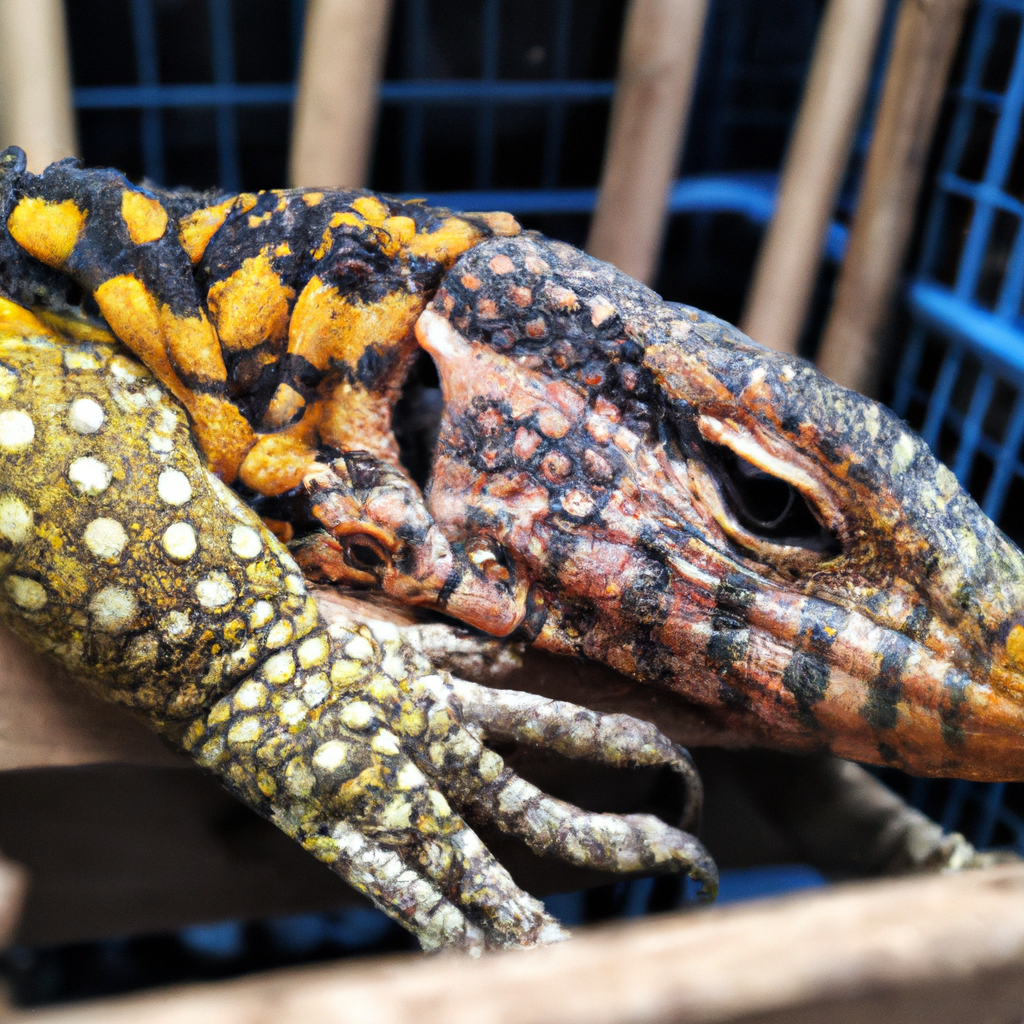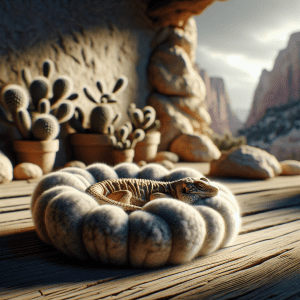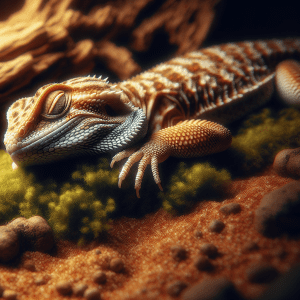Introduction to Lizard Sleep Patterns and Resting Areas
Have you ever stopped to ponder the mysterious world of lizards and their intriguing sleep patterns? It’s like diving into a hidden realm where these scaly creatures have their own unique bedtime stories to tell. From the vibrant geckos that dash around our walls to the majestic chameleons blending seamlessly into their surroundings, each lizard species carries its own bedtime rituals.
Picture this: a serene evening in a tropical rainforest, where the air is thick with moisture and the gentle rustling of leaves creates a soothing symphony. In this lush habitat, lizards find their cozy nooks to settle down for the night. Some seek refuge in the dense foliage, while others burrow beneath the earth, creating snug resting spots to drift off into lizard dreamland.
As we delve deeper into the realm of lizard sleep patterns, we uncover a world of wonder and curiosity. Did you know that certain lizard species are known to exhibit unique sleeping behaviors, such as the ability to sleep with one eye open? It’s a fascinating adaptation that allows them to stay alert to potential predators even while catching some Z’s.
Imagine observing a group of lizards basking lazily in the sun, their bodies perfectly still as they soak in the warmth. It’s a sight that reminds us of the delicate balance between rest and vigilance in the animal kingdom. Through their sleep patterns and resting areas, lizards unveil a captivating narrative of survival and adaptation in their natural habitats.
So, the next time you catch a glimpse of a lizard scurrying across your path or lounging in the sun, take a moment to appreciate the hidden world of their sleep patterns and resting areas. Who knows what other secrets these enigmatic creatures hold within their slumbering minds?
Importance of Understanding Lizard Resting Behaviors
Have you ever thought about how understanding lizard resting behaviors could actually benefit us in caring for them as pets? It’s fascinating to realize that by learning about the importance of lizard sleep patterns and resting areas, we can provide our scaly friends with the best possible environment for their well-being.
When we grasp the significance of these behaviors, we can tailor their habitats to mimic their natural resting areas, promoting their comfort and health. For instance, some lizard species prefer elevated perches for resting, while others may require burrowing spaces for optimal sleep. By observing and accommodating these preferences, we can ensure that our pet lizards feel secure and content in their environment.
Taking the time to research and understand the factors influencing lizard sleep patterns can also help us identify signs of stress or discomfort in our pets. Lizards may exhibit changes in their resting behaviors if they are not provided with suitable sleeping spots or if their habitat is not conducive to their natural instincts. By recognizing these cues, we can make adjustments to enhance their living conditions and overall quality of life.
Moreover, by delving into the intricacies of lizard resting behaviors, we can create a more enriching and stimulating environment for our pets. Incorporating diverse resting areas and enrichment activities can keep our lizards engaged and mentally stimulated, contributing to their overall happiness and well-being.
So, the next time you observe your pet lizard settling into a cozy nook or basking in the sunlight, remember that understanding their sleep patterns and resting areas is not just about their natural behavior—it’s also about providing them with a safe, comfortable, and enriching home where they can thrive.
Factors Influencing Lizard Sleep Patterns
Let’s delve into the fascinating world of factors influencing lizard sleep patterns! Did you know that various factors play a crucial role in determining how and when lizards catch their Z’s? Picture this – you’re out hiking in the desert, and you stumble upon a group of sunbathing lizards. Ever wondered why they choose specific spots to rest and sleep? Well, let’s break it down.
Lizards are ectothermic creatures, meaning their body temperature is regulated by external sources of heat. This dependence on environmental temperature directly influences their sleep patterns. When the sun sets, lizards seek out warmer spots to rest, allowing them to conserve energy and maintain their metabolic functions during periods of inactivity.
In addition to temperature, the availability of shelter and safety also impacts where lizards choose to snooze. Whether it’s hiding under rocks, burrowing in the soil, or perching on branches, lizards select resting areas that offer protection from predators and harsh weather conditions. These strategic choices not only ensure their safety but also contribute to their overall survival in the wild.
Moreover, the type of food lizards consume can influence their sleep patterns. After a hearty meal, lizards may opt for a cozy resting spot to aid digestion and conserve energy. The balance between feeding and resting is crucial for their daily routines and plays a significant role in their overall health and well-being.
Considering these factors, it becomes clear that lizard sleep patterns are intricately linked to their environment, behavior, and physiological needs. By understanding the factors that influence where and how lizards rest, we gain valuable insights into their natural behaviors and the delicate balance of life in the reptilian world.
Next time you spot a lizard basking in the sun or seeking refuge under a rock, take a moment to appreciate the intricate dance between environmental factors and their sleep patterns. It’s a reminder of the remarkable adaptations that enable these fascinating creatures to thrive in diverse habitats.
Common Resting Areas for Different Lizard Species
Let me tell you about the fascinating world of lizard resting areas. Did you know that different lizard species have unique preferences when it comes to their resting spots? From rocky crevices to tree branches and even burrows underground, lizards have diverse choices for their cozy nap spots.
Imagine a hot desert landscape, where you spot a desert iguana basking on a flat rock under the scorching sun. These lizards are often seen resting on elevated surfaces like rocks to absorb heat and regulate their body temperature effectively. It’s incredible how these creatures adapt to their environments, isn’t it?
The variety in lizard resting areas is not just limited to terrestrial habitats. Tree-dwelling lizards, such as geckos, prefer to rest on branches or in the hollows of trees. Their agile climbing abilities allow them to find secure perches where they can rest undisturbed. It’s like having your own cozy hammock up in the treetops!
Now, let’s switch gears and talk about the challenge of creating ideal resting areas for pet lizards. As reptile enthusiasts, we need to mimic the natural habitats of lizards to ensure their well-being in captivity. Providing a mix of hiding spots, basking areas, and climbing structures can help replicate the diverse resting environments that lizards seek in the wild.
When setting up a terrarium for a pet lizard, consider the specific needs of the species you are caring for. For example, arboreal lizards like chameleons will require vertical space with plenty of foliage for hiding and climbing, while ground-dwelling species like skinks might prefer a setup with sandy substrate and tunnels for burrowing.
Understanding the importance of lizard resting areas not only benefits pet owners but also contributes to our knowledge of these fascinating creatures’ natural behaviors. By observing and respecting their resting preferences, we can create enriching environments that promote the well-being of our scaly friends.
Adaptations of Lizards for Resting and Sleeping
You know, when it comes to lizards and their sleep patterns, there’s this fascinating fact that always blows my mind. Did you know that some lizard species can actually sleep with one eye open? Yes, you heard that right! It’s like they’re the ultimate multitaskers of the animal kingdom.
Imagine being able to catch some z’s while still keeping a vigilant eye out for predators or potential prey. Talk about a survival strategy that’s straight out of a spy movie! This unique adaptation showcases just how incredible these reptiles are when it comes to adapting to their environment and ensuring their safety even in their most vulnerable state.
This ability to remain partially alert while resting sheds light on the evolutionary traits that have allowed lizards to thrive in various habitats around the world. It’s a testament to their resilience and resourcefulness in the face of challenges that Mother Nature throws their way.
So, the next time you spot a lizard basking in the sun or taking a snooze on a tree branch, remember that there’s more to their seemingly peaceful slumber than meets the eye. Their ability to stay alert even while catching some shut-eye is just one of the many marvels of the natural world that never cease to amaze me.
Isn’t it incredible how such small creatures can possess such remarkable skills? It just goes to show that there’s always something new and intriguing to learn about the world around us, especially when it comes to the fascinating realm of lizard sleep patterns and resting areas.
Studying Lizard Sleep Patterns in the Wild
Let me tell you something fascinating about studying lizard sleep patterns in the wild. It’s like embarking on a thrilling adventure into the mysterious world of these scaly creatures. Picture this: you’re out in the wilderness, equipped with your research tools and a keen eye for observation. As you observe the lizards in their natural habitat, you start noticing their unique behaviors when it comes to resting and sleeping.
One interesting fact about studying lizard sleep patterns in the wild is that different species exhibit various sleeping habits. Some lizards are diurnal, meaning they are active during the day and rest at night, while others are nocturnal, preferring to hunt and move around under the cover of darkness. Imagine the incredible diversity of behaviors you would witness while observing these reptiles in their element.
As you delve deeper into your research, you may encounter challenges in accurately documenting the sleep patterns of lizards. Their elusive nature and camouflage abilities can make it tricky to track their resting behaviors effectively. However, with patience and perseverance, you can unravel the secrets of how lizards rest and recharge in their natural surroundings.
Have you ever wondered how studying lizard sleep patterns in the wild can contribute to our understanding of ecosystem dynamics? By examining the resting behaviors of lizards, researchers can gain valuable insights into the health of ecosystems and the impact of environmental changes on wildlife. It’s incredible to think about the interconnectedness of all living beings and how even the smallest creatures play a crucial role in maintaining ecological balance.
So, next time you spot a lizard basking in the sun or seeking shelter under a rock, take a moment to appreciate the intricate world of their sleep patterns and resting behaviors. Who knows what secrets these ancient reptiles hold, just waiting to be discovered in the wild?
Tips for Creating Ideal Resting Areas for Pet Lizards
Let me share a practical tip with you when it comes to creating ideal resting areas for pet lizards. You know, providing a comfortable and safe environment for your scaly friend is essential for their well-being. One key aspect to consider is the type of substrate you use in their enclosure. Some lizards prefer sand, while others may thrive better on a substrate that retains moisture, like coconut coir. It’s crucial to research the specific needs of your lizard species to ensure you choose the right substrate that mimics their natural habitat.
Additionally, incorporating plenty of hiding spots and climbing structures in the enclosure can help your lizard feel secure and reduce stress. Lizards, by nature, love to explore and find cozy spots to rest, so offering a variety of hiding places such as caves, logs, or plants can make them feel right at home.
Maintaining the right temperature and humidity levels is another vital aspect to consider. Lizards are ectothermic, meaning they rely on external heat sources to regulate their body temperature. Ensure that there are temperature gradients within the enclosure, including warm basking spots and cooler areas for your lizard to thermoregulate effectively.
Regularly cleaning and maintaining the resting areas is crucial for your pet’s health. Remove any uneaten food, feces, or shed skin promptly to prevent bacterial growth and maintain a hygienic environment. Providing fresh water daily is also essential to keep your lizard hydrated and healthy.
By implementing these tips and creating a comfortable, enriching environment for your pet lizard, you can ensure that they have a cozy resting area where they can thrive and exhibit natural behaviors. Remember, a happy and content lizard is a healthy lizard!
Impact of Environmental Changes on Lizard Resting Behavior
Imagine, for a moment, that you are a lizard navigating the ever-changing landscape of your habitat. You seek out the perfect spot to rest and rejuvenate, only to find that human activities have altered your once tranquil resting area. Yes, we are delving into the impact of environmental changes on lizard resting behavior—a topic that sheds light on the interconnectedness of all living beings.
As we step into the scaly skin of a lizard, we begin to understand the challenges they face when their resting areas are disturbed by human interference. The construction of roads, buildings, and other structures can disrupt their natural habitats, forcing them to adapt to new surroundings or face the risk of displacement. Picture yourself as a lizard, trying to find a safe and comfortable place to rest amidst the chaos of urban development.
This perspective allows us to appreciate the resilience of these fascinating creatures and prompts us to consider the broader implications of our actions on the delicate balance of ecosystems. How can we coexist harmoniously with wildlife, ensuring that lizards and other species can thrive in their natural environments?
By adopting a lizard’s viewpoint, we gain a deeper understanding of the importance of preserving and protecting their resting areas. Our choices and behaviors as humans have a direct impact on the well-being of these creatures. So, the next time you encounter a lizard basking in the sun or seeking shelter under a rock, remember the significance of providing undisturbed resting areas for these remarkable beings.
Let us reflect on the interconnectedness of all life forms and strive to create a world where lizards—and all living creatures—can find peace and tranquility in their resting areas.
Conservation Efforts to Protect Lizard Habitats
When it comes to conservation efforts to protect lizard habitats, it’s not just about the lizards themselves – it’s about the delicate balance of ecosystems they’re a part of. Imagine strolling through a vibrant rainforest, the lush greenery teeming with life. Now, picture that same forest without the scurrying of lizards, the rustling of leaves as they find their resting spots. It’s a different world, isn’t it?
To truly appreciate the significance of conserving lizard habitats, we must understand the interconnectedness of all living beings in these ecosystems. Lizards play vital roles as both predators and prey, influencing insect populations and maintaining the delicate equilibrium of their environments. Without them, the ecosystem could spiral into imbalance, affecting plants, animals, and even humans who rely on these diverse habitats for resources.
Consider this – did you know that certain species of lizards are key indicators of environmental health? By monitoring the presence and behaviors of these reptiles, researchers can gain valuable insights into the overall well-being of ecosystems. For instance, a decline in lizard populations could signal environmental degradation, prompting conservationists to take action to protect these habitats before irreversible damage occurs.
Protecting lizard habitats isn’t just about saving a particular species; it’s about safeguarding the intricate web of life that sustains our planet. Every tree, every rock, every patch of soil that provides a resting place for lizards is part of a larger tapestry of biodiversity. By preserving these habitats, we not only ensure the survival of lizards but also contribute to the preservation of entire ecosystems for future generations to cherish and learn from.
So, the next time you spot a lizard basking in the sun or scurrying across your path, take a moment to appreciate the role it plays in the grand symphony of nature. By valuing and protecting their habitats, we are not only safeguarding the future of lizards but also nurturing the rich tapestry of life that surrounds us.
Enhancing Knowledge of Lizard Sleep Patterns
Have you ever wondered how lizards manage to find the perfect spot to rest or sleep in their natural habitats? It’s truly fascinating to think about these seemingly simple creatures and the intricate behaviors they exhibit when it comes to resting. Imagine being able to observe a lizard in its resting state in the wild – what do you think would be the key factors influencing its choice of resting area?
As we delve into the world of lizard sleep patterns and resting areas, we uncover a whole new realm of discovery. These seemingly unassuming creatures have adapted in remarkable ways to ensure their rest and relaxation. From utilizing specific types of vegetation for camouflage to seeking out warm rocks for basking, lizards have developed unique strategies to optimize their resting experiences.
Consider this – lizards are cold-blooded animals, meaning their body temperature is dependent on the external environment. How do you think this impacts their choice of resting areas? Do they prefer sunny spots to warm up or seek out shaded areas to cool down? These questions open up a world of possibilities and insights into the behaviors of these fascinating reptiles.
Exploring the challenges and nuances of lizard sleep patterns and resting areas not only provides us with a deeper understanding of these creatures but also offers a glimpse into the complexity of nature’s design. So, the next time you catch a glimpse of a lizard basking in the sun or nestled in the foliage, take a moment to appreciate the intricacies of its resting habits and the wonders of the natural world around us.




